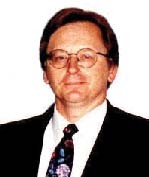
 | 2000 EMC
Symposium Experiment Demonstrations in Washington, DC |
By Andy Drozd, Vice Chair |
The turnout at this year's EMC Symposium experiment demonstrations in Washington, DC couldn't have been better! The three days of experiments once again proved to be an integral part of the symposium drawing sizable crowds, and stirring up lots of discussions and audience interaction. One individual I spoke to likened it to a "magic show" with a difference – much of the mystery behind EMC is revealed proving it is indeed an art and a science offering some interesting, unexpected, but always thought-provoking challenges. Were some clever tricks and secrets revealed? You bet they were and a good time was had by all!
Since inaugurating the forum in 1993, the experiments have helped raise the awareness level of engineers to the importance of implementing good EMC design and measurement practices as well as provide keen insights into electromagnetic phenomena and effects. What started out as a grand experiment itself nearly ten years ago is now becoming a traditional format. It's safe to say that we will continue to cultivate and possibly expand this forum in future symposia. In fact, we are about to launch another novel idea somewhat related to the experiment demonstrations, but more about that later.
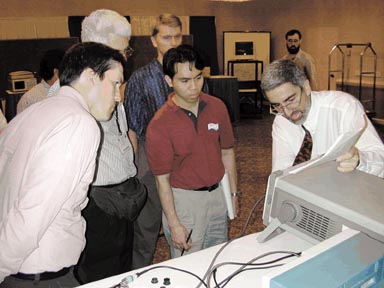 | 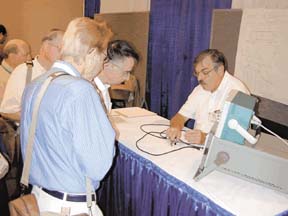 |
John
Daher of the Georgia Tech Research Institute demonstrates spectrum analysis using
a spectrum analyzer. | Clayton
Paul of Mercer University demonstrates the effects of pulse rise/fall on signal
spectrum. |
This year we had a very diverse mix of demonstrations covering the measurement of cable crosstalk and interference, to assessing the effectiveness of noise suppression techniques on PCBs, to computer modeling and validation. Up to five demonstrations were conducted continuously during each morning and afternoon period. The lineup this year included 23 experiment demonstrations. This was one of our more ambitious years and except for a few equipment setup problems, everything ran relatively smoothly. Recall that the experiments are partially based on the EMC Society Education Committee's EMC Experiments and Demonstrations Manual, Volume 1 originally compiled and reviewed by Clayton Paul and Henry Ott (a PDF version of this document can be downloaded from the IEEE EMC Society Web Site at https://www.emcs.org ). We added several other experiments to the agenda as in past symposia where some were of a more elaborate nature. The experiments demonstrated this year included:
"Separation of Common-Mode and Differential-Mode Conducted Emissions for Diagnostic Purposes" by Don Bush, dBi Corporation, Winchester, KY.
"Infrared Images of Electromagnetic Fields (Aircraft Scattering Model)" by John Norgard of the University of Colorado at Colorado Springs, CO and Michael Seifert of the Air Force Research Laboratory Information Directorate, Rome Research Site, Rome, NY.
"Simple Lessons Learned for EMI Control" by Jack Meyer of Anteon Corporation, Faifax, VA.
"Non-Ideal Behavior of Circuit Elements and the Effect on Signal Spectra" by Elya Joffe, KTM Project Engineering, Ltd., KFAR Sava, Israel.
"Study of the Effectiveness of ESD Suppression Devices and Topologies in Protecting a Timing Circuit" by Ahmad Fallah of Phoenix International, a John Deere Special Technologies Group Company; and Lincoln Davidson, President of Analog Design, LLC (this experiment was developed under the supervision of Dr. Robert Nelson from North Dakota State University).
"Spectrum of Non-Sinusoidal Signals" by Jose Perini, Professor Emeritus of Syracuse University.
"Conducted Mode Noise on Small DC Motors in a Shield Tool Box" by James Muccioli of Jastech EMC Consulting, LLC and X2Y Attenuators, LLC, Farmington Hills, MI.
"Compromises in Shielding Integrity" by Bill Duff of Sentel Corporation, Alexandria, VA and Ernie Freeman, SFA, Inc., MD.
"Analyzing Current Paths and Effects on Circuits" (based on Doug Smith's experiment "Noise Measurement by Induction") by Roy Ediss of Philips Semiconductors, Southampton, UK.
"Crosstalk Between Parallel Current Loops" by Hans Regtop of Philips Research Laboratories, EMC Department, Eindhoven, The Netherlands.
"Influence of Properties of Antennae on the Results of Measurements" by Vladimir Kraz, Credence Technologies, Inc., Santa Cruz, CA.
"Effects of PWB Layout on ESD Immunity" by Doug Smith, D. C. Smith Consultants, Santa Clara, CA.
"Spectrum Analysis Using a Spectrum Analyzer - The Basics and Some Subtleties" by John Daher, Georgia Tech Research Institute, Atlanta, GA.
"A Most Unusual Mode Stirred Chamber" by Mike Hatfield of the Naval Surface Warfare Center, Dahlgren Division, Dahlgren, VA.
"Artificial Lightning Generation" by Fred Heather of the Naval Air Warfare Center, Aircraft E3 Engineering Division, Patuxent River, MD.
"Demonstration of Modeling Simple Canonical Objects" by Maqsood Mohd of Sverdrup Technology, Eglin AFB, FL
"Parasitic Effects in Circuit Elements and the Effect on Signal Spectra" by Clayton R. Paul, Sam Nunn Eminent Professor of Aerospace Engineering and Professor of Electrical and Computer Engineering of Mercer University's School of Engineering, Macon, GA.
"Surge and Lightning Suppression Fundamentals" by Norman Violette of Violette Engineering Corporation, McLean, VA and Mike Violette of Washington Laboratories, Gaithersburg, MD.
"Spread Spectrum and The Electromagnetic Environment" by Art Light of ITT Industries, Alexandria, VA.
"How Parasitic Effects in Inductors and Capacitors Affect Electrical Equipment" by James J. Whalen, Department of Electrical Engineering, University of New York at Buffalo.
"Radiated Emission Due to the Finite Partial Inductance of PCB Ground Planes" by Frank Leferink of Hollandse Signaal-apparaten B.V., The Netherlands.
"Effects of Logic Devices and Their Spectral Emissions Profile" and "Effectiveness of Image Planes and Distance Spacing to Signal Traces on PCBs" by Mark Montrose of Montrose Compliances Services, Inc., Santa Clara, CA.
As usual, the presenters did an outstanding job. In upcoming newsletter articles we plan to highlight some of the interesting findings and results of several of these experiments. Stay tuned!
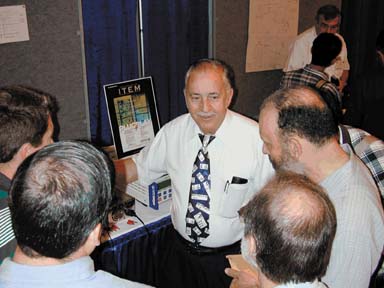 | 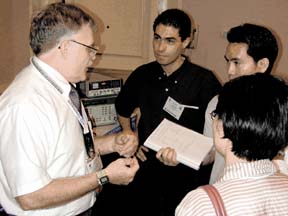 |
Norm
Violette of Violette Engineering Corporation demonstrates transient protection
of facilities and equipment. | Art
Light of ITT Industries demonstrates the EMC of spread-spectrum modulation. |
We are also indebted to the supporters behind the scenes who helped coordinate and make the detailed arrangements for this year's experiments session. These included my Co-Chair Larry Cohen of NRL, Greg Snyder and Mike Violette of Washington Laboratories, and Mike Hatfield of NSWC, Dahlgren who in team fashion helped acquire or supply the various test stands and other hardware for the demonstrations. We are also very grateful to Tektronix Inc., Rohde & Schwarz, Advantest, Agilent/Hewlett-Packard, Fluke Corporation, KeyTek, and Schaffner EMC for providing the special test equipment used in the experiments. It's mind-boggling to think of all the test equipment that is needed such as oscilloscopes, spectrum and network analyzers, EMI receivers, signal and function generators, meters and probes, and so on that these companies so readily supply us with each year. Greg Snyder by the way did an exceptional job coordinating, setting up, and dismantling the experiment stations. Thank you Greg and all of our supporters for another successful event!
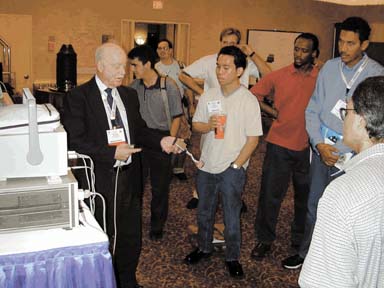 |
Ron
Duffy of Agilent Technologies discussed line filter design with product safety
implications. |
We have already begun planning next year's experiments session and have a candidate list of demonstrations that have been volunteered. For Montreal we are also conducting a "Call for Experiments" in an attempt to solicit other novel ideas that would be of interest. Our hope is to expand and continue to maintain the high quality that the forum is known for while adding to the growing suite of experiments documented in the EMC Experiments and Demonstrations Manual. It is anticipated that next year's experiments for Montreal would be selected with the aid of an impartial symposium technical evaluation committee, so if you have ideas for an experiment and want to have it considered, please contact me at (315) 334-1163 or 337-4396, a.l.drozd@ieee.org to discuss your ideas and get the ball rolling. Our goal is to establish a preliminary agenda of experiments by early December 2000.
Periodically visit the official Montreal 2001 IEEE International Symposium EMC Web Site to find out more about the upcoming conference and session agendas. The site will also provide a list of experiment topics being considered. The experiments are to be located in an open venue once again nearby to the technical paper sessions and vendor exhibits in the Palais des Congres de Montreal. The URL for the Montreal Symposium Web Site is www.2001emcmtl.org or go directly to the EMC Society home page to link to their site. We look forward to your comments and suggestions on novel ideas for experiments. The advice I usually give is to keep it simple and base the experiment on the use of some fairly ordinary test equipment. This is not to say that more elaborate ideas will not be considered.
What do I mean? Well, we will be making use of the tried and true experiments format to launch a new special session aimed at demonstrating computational electromagnetics computer modeling and simulation methods for basic EMC problems. The growing importance of CEM modeling, simulation and analysis in our discipline and within our Society, as well as the formation of a number of CEM groups outside of the Society have stimulated a great deal of interest in this area. CEM represents the synergy among electromagnetics, mathematics, numerical methods and computer science.
We are looking at alternative ways of educating EMC engineers in the fundamental of computer modeling and simulation including perhaps some of the more advanced computational techniques for EMC problem solving that are available today. We would like to appeal to both the novice and experienced EMC engineer in this regard, so a proper balance of demonstrations and software technologies would need to be brought together in this forum. The software demonstrations will be based on: (a) simple models or example problems that could be efficiently simulated on a personal computer; (b) emphasizing the physics and solution methods behind the software tool rather than the tool itself; (c) an experiment counterpart for conducting empirical-analytical validations when possible; and (d) the use of software tools, technologies and techniques that are not subject to export control restrictions and are not proprietary (e.g., applying a public domain university developed tool perhaps?).
It is important to add that every effort will be made to prevent commercialism and to dissuade any type of commercial product endorsements. This will be a challenging endeavor as you can tell. Nevertheless, we plan to test out the idea in Montreal. The computer simulation demonstrations will be conducted in parallel with the hardware experiment demonstrations. Please let me know what you think and if you have any thoughts on an interesting simulation you would like considered.
Well, quite possibly. How do standards fit into EMC education and the demonstrations? The answer is awareness and a better understanding of the validation problem. The electromagnetics community at large is being prodded for good reason to get even more serious about developing modeling standards that could be used to cross validate various CEM codes as well as compare simulation results to measurements. Developing sound standards is one potential solution to the validation issue. For example, the structural and thermal engineering, and computational fluid dynamics communities have taken big steps towards developing standards to support collaborative, concurrent, and integrated product team engineering tasks. There is still some controversy with applying CEM tools in a similar way. Some have questioned the validity and legitimacy of comparing the results of diverse simulation methods because of the various ways in which a given problem can be defined. With these points in mind, suffice it to say that the experiments and modeling-simulation demonstrations may lead to some interesting observations and conclusions on the relevancy of standards for CEM simulations and validations. I also note that there is an initiative within the EMC Society Standards Development Committee to investigate the possible generation of a CEM modeling standard. I hope to address this matter further in a future newsletter article as developments occur.
Stay tuned. EMC